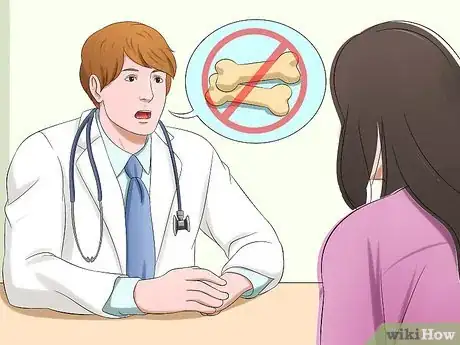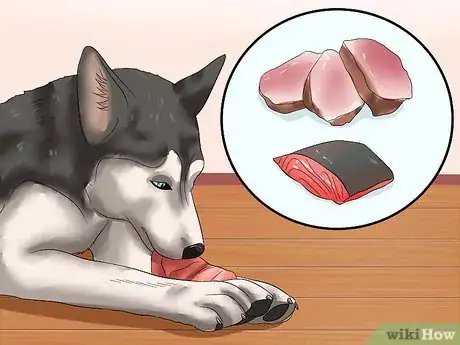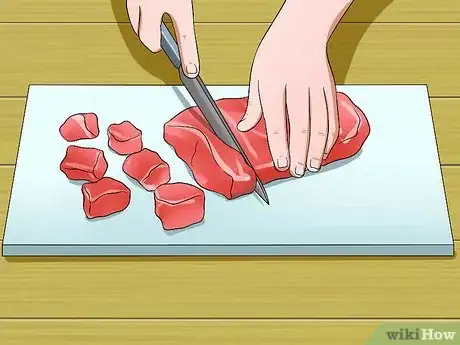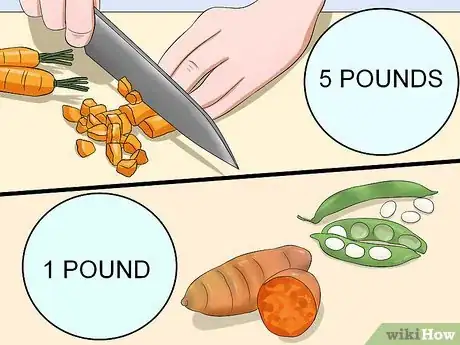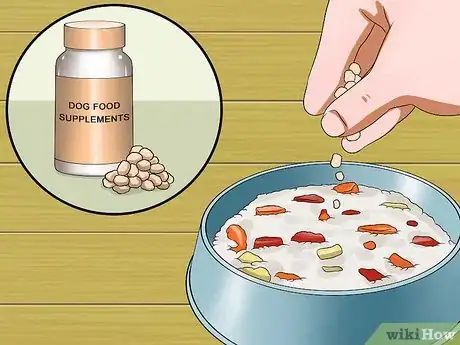This article was co-authored by Pippa Elliott, MRCVS. Dr. Elliott, BVMS, MRCVS is a veterinarian with over 30 years of experience in veterinary surgery and companion animal practice. She graduated from the University of Glasgow in 1987 with a degree in veterinary medicine and surgery. She has worked at the same animal clinic in her hometown for over 20 years.
There are 8 references cited in this article, which can be found at the bottom of the page.
This article has been viewed 162,104 times.
If your dog's skin has become sensitive, red, itchy, and inflamed, but you can't seem to find a cause, your dog may be intolerant to something he's eating. In severe cases or if your dog is allergic (which isn't as common as an intolerance), your dog may scratch the sensitive skin to the point that it causes skin infections. Talk with your veterinarian to develop a dietary plan and learn how to make specialized food for your dog.
Steps
Considering Diet Options
-
1Have your dog examined for a food allergy. If you notice your dog scratching his irritated or sensitive skin, or if his ears and skin are greasy and smelly, take your dog to the vet. The veterinarian will check for causes of itchiness and irritation, such as parasites, and may suggest testing for environmental allergens or putting the dog on a trial elimination diet.[1] Allergies are usually caused by the proteins in your dog's food, although common causes are beef, chicken, dairy, wheat, corn and soy.[2] These also happen to be the most common ingredients that make up commercial dog foods.
- Preservatives and filler ingredients can also irritate your dog's digestion.
-
2Consider an elimination diet. Since so many ingredients, fillers, and preservatives make up commercial dog food, the vet will probably recommend a food elimination trial. To do this, you'll choose a food sensitivity diet to exclusively feed your dog.[3] Avoid feeding any foods that aren't part of the chosen diet. This will help you determine what substance is bothering your dog.
- Remember not to feed treats or rawhide bones during the elimination diet. While this may seem harsh, it will take up to 6 weeks for your dog's body to “clear” the offending allergens from the body. Any other food during this time could potentially cause the diet to fail.
Advertisement -
3Choose a food sensitivity diet to try. When you're ready to closely monitor a strict diet for your dog, you'll need to select a food sensitivity diet. This way, you know exactly what your dog is eating. After several weeks, you should notice an improvement in your dog's allergies or you may realize that something in that particular diet is causing the problem. Some food sensitivity diets to try include:
- Novel protein: With this diet, you'll choose a single source of a non-typical meat that your dog has never had before. This might include salmon, venison, buffalo, or duck, but only give your dog 1 of these proteins, not all 3. Since your dog hasn't been exposed to the protein, there's less of a chance that he's developed an allergy to it.
- Hydrolyzed protein: This diet is made up of proteins that are broken down into small component amino acids (which make up the protein). Since they're so small, your dog's body shouldn't notice the protein, preventing an allergic reaction.[4]
- Therapeutic: These diets which use a novel or hydrolyzed protein are made with higher levels of omega-3 and omega-6 fatty acids which can reduce the symptoms of food allergies.[5]
-
4Work with the veterinarian to create a balanced diet. Once you and your veterinarian have determined the cause of your dog's allergies, choose a nutritious diet. The vet may recommend purchasing a specific commercial product or may prescribe a detailed diet for you to make for your dog. If you do decide to make your own food, you'll need to consult a certified nutritionist or dietitian who has spoken to your vet about your dog's dietary needs.[6]
- A specialized diet is important for your dog since dogs have different mineral and vitamin requirements than humans. Most dogs do well on a diet made up of 40 percent meat, 50 percent vegetables and 10 percent carbohydrates.
Creating a Homemade Diet
-
1Prepare to make your dog's food. Once you have a rough idea of the diet your veterinarian and nutritionist recommend, decide if you'd like to make a cooked or raw diet. This is a matter of personal preference, although dogs with certain medical conditions like an overactive immune system or inflammatory bowel disease (IBD) should probably avoid a raw allergy diet.
- Regardless of whether you choose to prepare a cooked or raw food, buy the best quality ingredients you can afford. Once you decide on a novel protein and carbohydrate, you need to stick with that meat and not give any other.
-
2Prepare the meat. Wash your hands before handling the food and chop the meat into small pieces suitable for the size of your dog. If cooking, place the meat in a large cooking pot. To make a large batch, choose 4 pounds (1.8 kg) of a protein like:
- Venison
- Bison
- Duck
- Ostrich
- Turkey
-
3Mix in oil and cook. If cooking your dog's food, stir 4 fluid ounces (120 mL) of olive oil to the pot with the meat. Cook the mixture until the meat is almost completely cooked through.
-
4Add vegetables and carbohydrates. If feeding your dog a raw diet, make sure the vegetables and carbohydrates you choose are cut small enough and are soft enough for you dog to eat without requiring cooking. If you're cooking the food, add 5 pounds (2.3 kg) of vegetables and 1 pound (0.45 kg) of carbohydrates. The vegetables can be fresh or frozen, but try to include a mix of at least 2 vegetables. Cook the meat, vegetable, and carbohydrate mixture until completely cooked. Some good vegetables and carbohydrates include:[7]
- Vegetables:
- Broccoli
- Carrots
- Green beans
- Celery
- Spinach
- Squash
- Carbohydrates:
- Sweet potato
- Lima beans
- Apples
- Peas
- Lentils
- Garbanzo beans
- Vegetables:
-
5Portion the food and give supplements. If cooked, let the food cool before mixing in any recommended nutritional supplements. Mix it well and divide the food into individual servings before freezing them. If giving a supplement, you can also give the recommended amount to the top of your dog's food just before serving it.
- Your veterinarian may recommend a complete dog vitamin that includes all the vitamins and minerals your dog needs. Other supplements include probiotics and omega fatty acids.[8]
Expert Q&A
-
QuestionCan I give my dog an antihistamine?
 Pippa Elliott, MRCVSDr. Elliott, BVMS, MRCVS is a veterinarian with over 30 years of experience in veterinary surgery and companion animal practice. She graduated from the University of Glasgow in 1987 with a degree in veterinary medicine and surgery. She has worked at the same animal clinic in her hometown for over 20 years.
Pippa Elliott, MRCVSDr. Elliott, BVMS, MRCVS is a veterinarian with over 30 years of experience in veterinary surgery and companion animal practice. She graduated from the University of Glasgow in 1987 with a degree in veterinary medicine and surgery. She has worked at the same animal clinic in her hometown for over 20 years.
Veterinarian The majority of antihistamines are safe for dogs but always check with a vet before giving it to a dog, especially if they are on other medications. Also, never given an antihistamine that contains xylitol as an added ingredient, as this is toxic to dogs.
The majority of antihistamines are safe for dogs but always check with a vet before giving it to a dog, especially if they are on other medications. Also, never given an antihistamine that contains xylitol as an added ingredient, as this is toxic to dogs. -
QuestionWhat can I give my dog for allergies?
 Pippa Elliott, MRCVSDr. Elliott, BVMS, MRCVS is a veterinarian with over 30 years of experience in veterinary surgery and companion animal practice. She graduated from the University of Glasgow in 1987 with a degree in veterinary medicine and surgery. She has worked at the same animal clinic in her hometown for over 20 years.
Pippa Elliott, MRCVSDr. Elliott, BVMS, MRCVS is a veterinarian with over 30 years of experience in veterinary surgery and companion animal practice. She graduated from the University of Glasgow in 1987 with a degree in veterinary medicine and surgery. She has worked at the same animal clinic in her hometown for over 20 years.
Veterinarian Sadly, antihistamines are little help in dogs. Giving an Omega 3 & 6 supplement helps to condition the skin and make it a better barrier to allergens, plus it has a mild anti-inflammatory effect. Keeping the dog's skin clean and washing immediately after contact with an allergen will reduce the urge to itch.
Sadly, antihistamines are little help in dogs. Giving an Omega 3 & 6 supplement helps to condition the skin and make it a better barrier to allergens, plus it has a mild anti-inflammatory effect. Keeping the dog's skin clean and washing immediately after contact with an allergen will reduce the urge to itch. -
QuestionHow do you know if your dog is allergic to something?
 Pippa Elliott, MRCVSDr. Elliott, BVMS, MRCVS is a veterinarian with over 30 years of experience in veterinary surgery and companion animal practice. She graduated from the University of Glasgow in 1987 with a degree in veterinary medicine and surgery. She has worked at the same animal clinic in her hometown for over 20 years.
Pippa Elliott, MRCVSDr. Elliott, BVMS, MRCVS is a veterinarian with over 30 years of experience in veterinary surgery and companion animal practice. She graduated from the University of Glasgow in 1987 with a degree in veterinary medicine and surgery. She has worked at the same animal clinic in her hometown for over 20 years.
Veterinarian A dog with a food allergy may be itchy, get regular ear infections, or have tummy upsets. Signs of an allergy to something in the environment include itchiness, typically affecting the paws, face, or belly.
A dog with a food allergy may be itchy, get regular ear infections, or have tummy upsets. Signs of an allergy to something in the environment include itchiness, typically affecting the paws, face, or belly.
References
- ↑ https://www.aspca.org/pet-care/dog-care/allergies
- ↑ http://www.petmd.com/dog/centers/nutrition/evr_dg_best-dog-food-for-dogs-with-food-allergies
- ↑ https://www.dvm360.com/view/food-hypersensitivities-performing-elimination-diet-trial
- ↑ Muller and Kirk's Small Animal Dermatology. W. H. Miller Jr., C. E. Griffin, K. L. Campbell. Elsevier Health Sciences. 2013
- ↑ http://www.peteducation.com/article.cfm?c=2+1659&aid=666
- ↑ http://vet.osu.edu/vmc/companion/our-services/nutrition-support-service/home-made-diets
- ↑ http://pets.webmd.com/dogs/guide/raw-dog-food-dietary-concerns-benefits-and-risks
- ↑ http://www.petmd.com/dog/nutrition/evr_multi_dietary_supplements
About This Article
To make allergy food for dogs, chop up the meat of your choice, such as venison, turkey, or duck, into small pieces suitable for the size of your dog. Next, put the meat into a pot, add 4 ounces of olive oil, and heat the mixture until the meat is cooked through. Then, let the mixture cool before mixing in any nutritional supplements recommended by your vet. Finally, divide the food into individual servings before freezing them. For tips on preparing a raw diet for your dog, read on!

